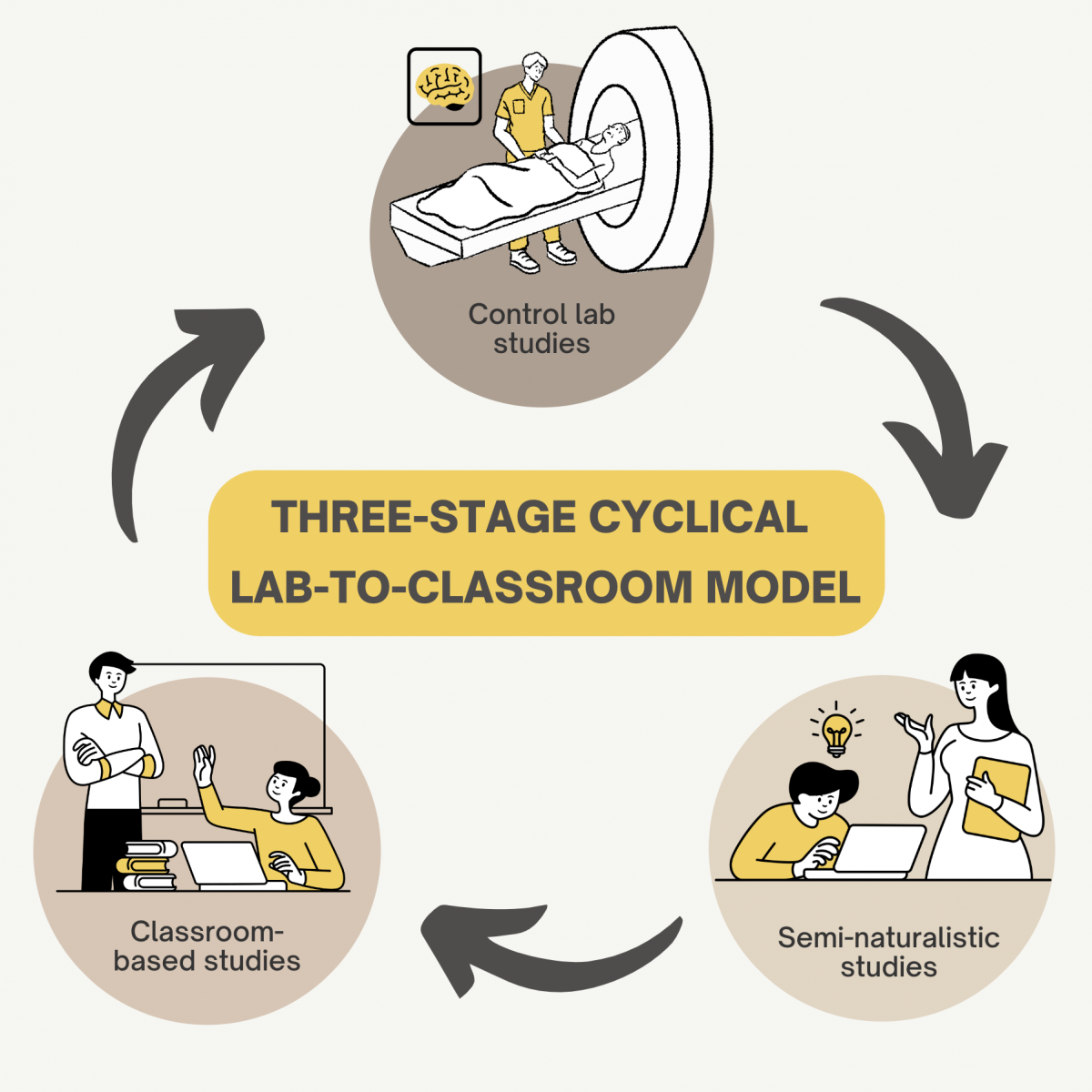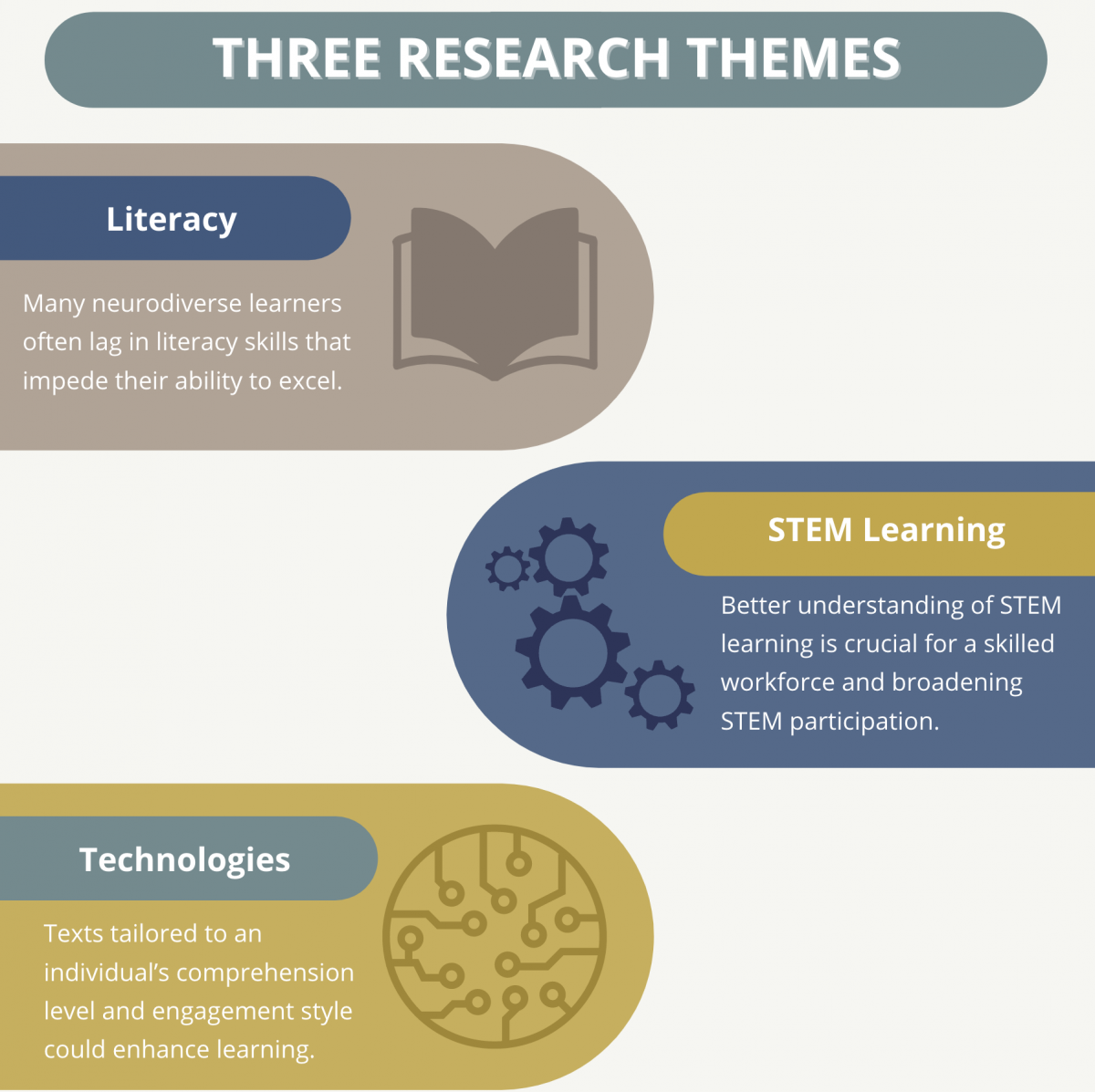Research Models


Bidirectional Learning Approach
- Research proposals are developed among a diverse group of researchers with the input of stakeholders (e.g., educators, neurodiverse learners and families, advocacy groups, policy makers, and education-related industry/NPOs), followed by an incubation period for discussions of how to best ground research questions in pedagogical practice.
- Bidirectional reflection reduces the risk of premature translation or mistranslation. Instead, translation from research to practice is grounded in research, and richly informed by our understanding of pedagogical practice, students’ experiences, and trends in policy and advocacy
A Three-Stage Cyclical Lab-to-Classroom Model
- EdNeuro studies vary in two often antagonistic dimensions, experimental control and ecological validity. The current proposal adopts an innovative Cyclical Model to balance these dimensions.
- In our model, investigations can begin at any of three stages, though comprehensive understanding requires completing the cycle:
- Controlled laboratory-based experiments (e.g., an fMRI study where participants watch controlled dot clouds that differ in their numerosity)
- Semi-naturalistic investigations incorporating naturalistic stimuli and tasks within a lab-based environment, or an experimentally controlled task delivered in a real-world learning environments (e.g., an fMRI study where participants watch a pre-recorded lecture);
- Fully-naturalistic investigations, using portable brain technologies in real-world learning environments (e.g., a classroom-based EEG study)
- Within the cyclical model, research can flow from the lab to the classroom, but it can also advance in the opposite direction where classroom-based investigations generate new research questions that are tested in controlled-laboratory studies.
Convergence Research in EdNeuro
- Convergence research has two primary characteristics: (1) Specific and compelling problems; and (2) Deep integration across disciplines.
- With respect to the first characteristic, at present, many educational policies and practices fail to benefit from scientific findings due to:
- lack of sufficient bi-directional communication between researchers and stakeholders;
- premature or misapplied translation of findings from cognitive neuroscience to educational practice (a risk due to the complexity of the data);
- continual, rapid expansion of our knowledge base; and/or
- fear among stakeholders that science has yet to reach a conclusion.
- With respect to the first characteristic, at present, many educational policies and practices fail to benefit from scientific findings due to:
- TRANSCEND aims to combat the translation problem utilizing convergence research principles, and provide transdisciplinary training in EdNeuro. Drawing on the breadth of expertise among faculty and Partner Organizations, trainees from diverse backgrounds will gain experience in key areas through our curriculum.
- Through the deep integration of research adopting bidirectional and cyclical approaches coupled with transdisciplinary training, our goal is for trainees and stakeholders, to co-create translational knowledge and tools to improve educational practice and allow personalized learning that would benefit all learners, with particular focus on diverse learners.
Research Themes

TRANSCEND identified three research themes based on (1) societal needs; (2) the need for deep integration (convergence) across disciplines via the cyclical model; (3) opportunities to leverage new initiatives and strategic plans at UConn; and (4) the expertise and funded activities of our faculty. These themes are Literacy, STEM Learning, and Next Generation Learning Technologies. Across all three research themes, we will take an individual differences approach to understanding neurodiversity, with the ultimate goal of contributing to an education system that will be able to serve all learners through personalized learning.
Theme 1: Literacy in EdNeuro
- Faculty: The team has expertise in language and literacy learning, dyslexia and reading instruction (Nicole Landi, Fumiko Hoeft, James Magnuson, Inge-Marie Eigsti) and relevant methods (e.g., neuroimaging, computational modeling, AI-ML, eye-tracking, person-person EEG [e.g. Ido Davidesco])
- Significance: Many neurodiverse learners have strengths in critical STEM workforce skills, such as visuospatial ability, mental imagery, logical thinking, and entrepreneurship, but often lag in literacy skills that impede their ability to excel. Literacy is thus a vital area of investigation for addressing neurodiversity in STEM. The vast majority of EdNeuro research in literacy is done in artificial laboratory settings. While research shows significant neural plasticity for reading, from pre-to-post intervention or over normal development, it has not yet revealed why many children show limited gains despite similar starting points and/or intervention content. This may be due to factors such as subject-level variability, variability in data signal, failure to measure important predictors, and limitations of commonly used statistical models. Moreover, most designs have limited ecological validity, because they are grounded in the lab (MRI studies), and because many interventions are designed by researchers without practitioner feedback.
Examples of research along the cyclical model
Type of study |
Examples |
References |
Semi-naturalistic study |
Nicole Landi has established partnerships with and built EEG laboratories within dyslexia schools (e.g., AIM Academy, the Windward School) to track students longitudinally, frequently in ecologically valid settings. One goal is to identify predictors of intervention response to ultimately develop more personalized treatment. | Landi, N.; Ashton, G.; Coyne-Green, A.; Kleinman, D.; Sarles-Whittlesey, H.; Roberts, P.; Blair, N.; Pugh, K.; Hoeft, F. What’s the Promise of in-School Neuroscience? Int. Dyslexia Assoc. 2019, 8 (3). |
Classroom-based study |
TRANSCEND trainees could collaborate on a fully naturalistic classroom-based study to examine if online engagement during learning predicts reading intervention outcomes, which has not been examined before. This work would dovetail nicely with the classroom research proposed in Theme 2, and would lead to collaborative teams focused on STEM/Literacy, both with a common in-classroom EEG design. |
Theme 2: STEM Learning in EdNeuro
Faculty: This team consists of expertise in STEM education (Ido Davidesco, Fabiana Cardetti); STEM higher education (Arash Zaghi, Jino Bi); and neuroimaging and other relevant methods (e.g. Fumiko Hoeft, Nicole Landi)
Significance: Better understanding of STEM learning, especially among neurodiverse learners, is critically important for the development of a skilled and competitive workforce and for broadening participation in STEM. Cognitive neuroscience research on reasoning, numerical processing, problem solving, and the construction of mental models can offer a new perspective on STEM learning in both neurotypical and neurodiverse learners. The TRANSCEND program will generate unique opportunities for trainees to collaborate with STEM education, neuroscience, and psychology researchers, and teachers, to address cutting-edge questions such as how individual differences in brain characteristics relate to STEM learning outcomes, and whether math intervention programs lead to brain changes that precede observable behavioral changes.
Examples of research along the cyclical model
Type of study |
Examples |
References |
Semi-naturalistic study |
Trainees may begin to tackle this issue in a controlled-laboratory experiment where participants will interact with a computerized math tutor. EEG and eye tracking data will be collected alongside self-reported and observational measures to gain a deeper understanding of how students engage in math learning | |
Classroom-based study |
Building on Ido Davidesco’s EEG classroom research, and in collaboration with other TRANSCEND faculty (Fabiana Cardetti, Fumiko Hoeft, Nicole Landi), trainees will collect EEG data in STEM classrooms, now possible with recent developments in portable EEG technology, and new ML-based analytical methods that capture interactions between learners. For example, a project could compare brain activity of students who, based on video data, appear disengaged during group work whose brain activity could in fact be tightly synced with their peers, indicating high cognitive engagement; with that of other group members. Trainees could also compare neural synchrony of neurodiverse and neurotypical students to better understand individual differences in engagement with STEM learning. | Davidesco, I.; Bevilacqua, D.; Poeppel, D.; Dikker, S. Neuroscience Research in the Classroom: Portable Brain Technologies in Education Research. Educ. Res. 2021, 0013189X211031563. |
Lab-based study |
Trainees may also investigate how neurodiverse learners engage with STEM content presented online rather than face-to-face (e.g., students will view educational videos that are manipulated of instructional content not feasible in real-world classrooms, while their brain activity is being recorded). |
Theme 3: Next-Generation Learning Technologies
- Faculty: Our team consists of an engineer (Arash Zaghi) and a computer scientist (Jinbo Bi) who bring expertise in AI-ML approaches for personalized learning; and experts in learning technology with NIH/NSF funding (Arash Zaghi, Fumiko Hoeft, Nicole Landi), and neuroimaging and related methods for neurodiverse learners. Industry partners such as Microsoft (providing NLP models such as Transformers and OpenAI) and Newsela/Houghton Mifflin Harcourt (for scientific texts) will be particularly relevant, in addition to STEM educator partners
- Significance: Neurodiverse learners in STEM learning often encounter challenges comprehending written material despite intact or even above-average STEM-related skills. For these students, modified texts tailored to the individual’s comprehension level and engagement style could enhance STEM learning and the individual’s success, especially because the factors that challenge reading comprehension vary from language processing in ASD, decoding in dyslexia, to attention and working memory in ADHD.
Examples of research along the cyclical model
Type of study |
Examples |
Semi-naturalistic study |
The customized texts may be presented to new participants and in different types of neurodiverse learners such as those with ASD in a semi-naturalistic classroom setting, and their comprehension may be tested. The same data will be collected with texts generated by the NLP without fine tuning for comparison. Student comprehension will be compared across conditions and across groups; fine-tuning will be performed iteratively to enhance comprehension. |
Classroom-based study |
Comprehension data from this approach may be collected in a real classroom, to investigate the scalability of the approach. |
Lab-based study |
High quality textbooks will be used to select texts about STEM-relevant concepts. In exploratory research, however, we will compare performance using texts generated from textbooks to those generated by a powerful NLP model such as GPT-3 (OpenAI) provided by industry partner Microsoft. Linguistic features of the texts will be extracted. First, based on data from typical readers, science texts will be categorized into those that were comprehended versus not. EEG data will be obtained while individuals read texts, and EEG-based classifiers will be generated from records that are labeled with respect to their comprehension (and agnostic to individual text characteristics). Next, neurodiverse learners’ EEG data (e.g., dyslexia) will be used to test these classifiers when they read the same science texts and then further tested when they read the simplified texts generated by a Transformer, e.g., GPT-3. If the classifiers performance becomes better with AI-generated texts, the GPT models can be fine-tuned until the best performance is obtained. We will obtain complementary information from neurodiverse learners on their reading comprehension and their user experience (e.g., “How much easier and more enjoyable were these texts to read than the original?”) to complement the EEG-based approach to tweek the ML models. We will also compare performance between behavioral response-based and EEG-based classifiers. This will serve as the first exploratory step in developing personalized science teaching material for neurodiverse learners. |